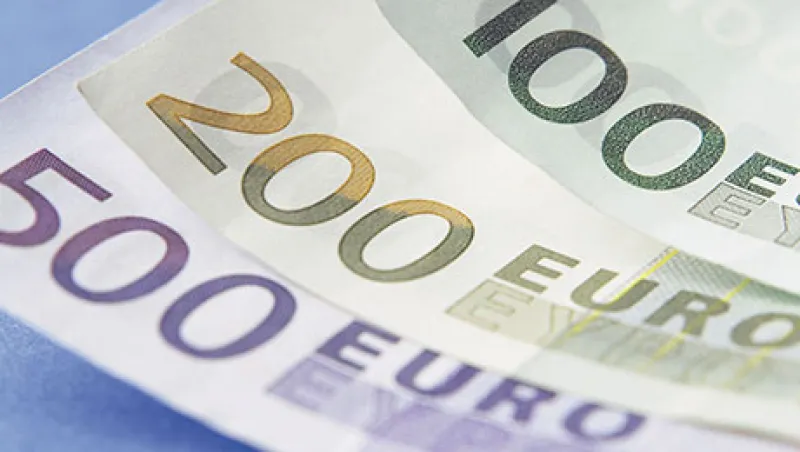The euro’s 12-year lows against the U.S. dollar stir contradictory sentiments at big U.S. companies.
On one hand, it hurts U.S. companies by increasing the price of their exports to Europe and lowering the dollar value of the revenue they earn there. On the other hand, minuscule European interest rates that have helped spark the euro’s plunge have given U.S. companies an attractive opportunity to issue bonds denominated in euros. U.S. corporations are taking advantage of that opportunity in a major way.
“It’s a positive trend for everyone, issuers and investors,” says Josh Witz, co-head of debt capital markets origination for SG Securities Services in New York.
Euro-denominated corporate debt has been a hot ticket around the world. According to financial data provider Dealogic, global issuance of bonds denominated in the 19-nation currency reached $424 billion in 2014, more than twice the 2011 figure, and that issuance has reached $185 billion so far this year. U.S.-headquartered companies have sustained much of this momentum, having issued so far this year $43.68 billion of Eurobonds — the second-highest amount for that period ever — trailing only pre-financial-crisis 2007, Dealogic data show. U.S. issuance has risen since 2011, totaling $92.49 billion last year, a number also topped only in 2007. The four biggest U.S. corporate Eurobond offerings over the past six months include an €8.5 billion ($9.5 billion) issue from Coca-Cola Co., a €3.8 billion issue from AT&T, a €3 billion offering from Berkshire Hathaway and a €2.8 billion issue from Apple.
U.S. companies love the low interest rates they pay on Eurobonds, thanks largely to the European Central Bank’s quantitative easing. The Bank of America Merrill Lynch U.S. Corporate index of investment-grade corporate bonds issued in dollars has a yield of 2.91 percent, whereas Eurobonds are priced at only 0.92 percent. A year ago, dollar bonds went for 3.19 percent and Eurobonds were priced at 1.82 percent.
For U.S. companies that want to convert the euro proceeds of their bonds into dollars, the cost of doing so as well as hedging the currency exposure through the use of cross-currency basis swaps has stood below historical averages for the past three years. A few of the companies issuing Eurobonds have no connection to Europe at all. But most of the U.S. companies issuing Eurobonds are doing business in Europe and thus have no need to convert the euro proceeds into dollars. Indeed, the Eurobonds can act as a natural hedge against their exposure to a falling euro, which lessens the value of their euro earnings in dollar terms.
The corporations are using the proceeds for a variety of purposes. “Late in the credit cycle, companies’ cash balances tend to get used up. And as balance sheets come down, they issue more debt for capital expenditures, share repurchases, acquisitions and dividends,” says Amy Judd, senior vice president of fixed income for AllianceBernstein in New York.
Issuing Eurobonds also allows U.S. companies to increase their investor base. “The more liquidity you can provide to investors, the bigger the investor base you can tap into,” says James Athey, a London-based fund manager at Aberdeen Asset Management, which has bought some of the U.S.-issued euro-denominated bonds. “European monetary policy is likely to remain easy for a considerable period of time. From a macro perspective, it’s an attractive story in euro-denominated assets,” he continues. Given that many European government bonds now have negative yields, the bonds from U.S. companies look quite attractive. European investors are the biggest buyers of the U.S. bonds.
Requesting anonymity, one market player says investors like the diversification that U.S. names provide for their Eurobond portfolio. In the early days of the euro, European investors had an appetite for U.S. companies’ Eurobonds only if the companies had products you could “eat, drink, smoke or drive,” says SG Securities’ Witz. But “the European investor base has matured,” he says. “They need to put their money into new names at more than the near-zero percent they’re getting on Bunds.”
Investors are now willing to look further out on the maturity curve and further down the credit-quality spectrum in buying U.S. companies’ Eurobonds, Witz and others say.
To be sure, the cost of cross-currency basis swaps has doubled since late December, which could put a damper on the issuance of Eurobonds by U.S. companies. But the yield difference between dollar and Eurobonds, as the ECB continues quantitative easing, will keep this an attractive potential source of inflows for corporations.
“I think the [heavy issuance] trend will continue. We are hearing that more supply is coming, some of it a hybrid of debt and equity,” Judd says.
Get more on fixed income .







